Materials Solutions: Expertise in metal Additive Manufacturing for the aerospace and motorsport industries
Materials Solutions Limited, located in Worcester, UK, is a world-class specialist in the Additive Manufacturing of functional parts using the Selective Laser Melting process. Dr David Whittaker reports for Metal Additive Manufacturing magazine on a visit to the company, where he spoke with founder and Managing Director, Carl Brancher. [First published in Metal AM Vol. 1 No. 2, Summer 2015 | 15 minute read | View on Issuu | Download PDF]
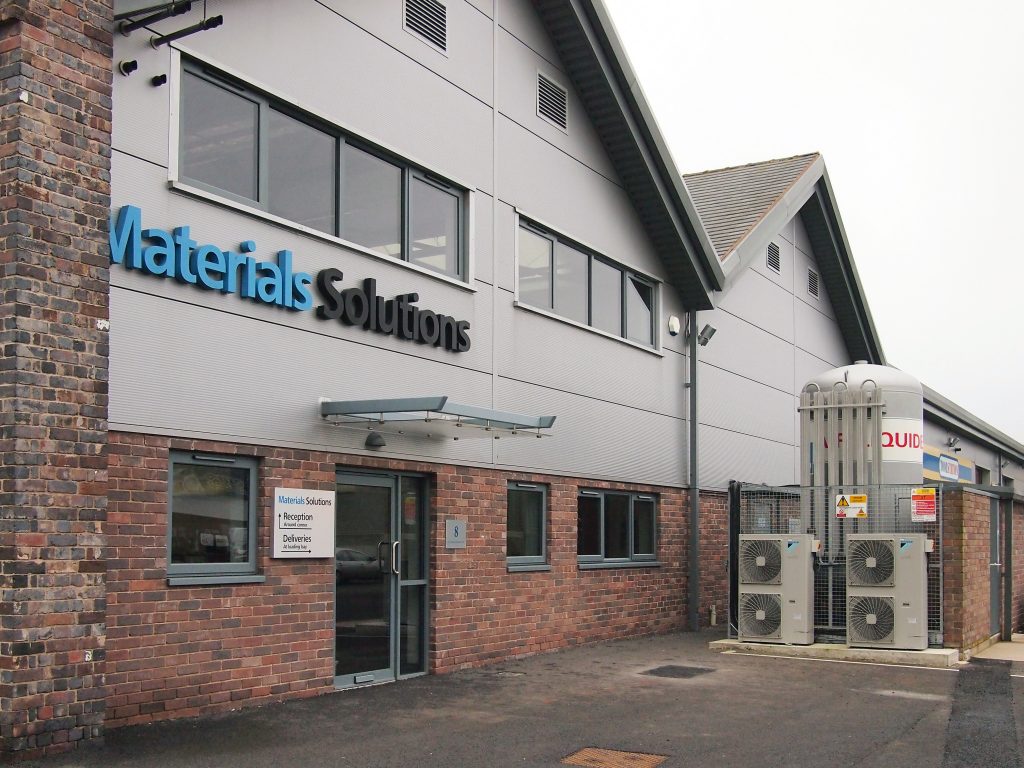
Materials Solutions was founded in 2006 following a successful bid for grant funding from the UK’s Micro and Nano Technology (MNT) scheme administered by the then regional development agency, Advantage West Midlands. The company started its Selective Laser Melting (SLM) operations in around 500 m2 of laboratory space on the campus of the University of Birmingham. Initially, the company had evaluated the potential for commercialisation of a number of emerging manufacturing technologies before settling on SLM as the candidate to take forward. Brancher commented, “Unlike other options, the Additive Manufacturing of metals in general, and SLM in particular, excited significant potential end-user interest, which promised a strong market pull for its subsequent commercialisation.”
In the SLM process, a metal powder is spread across a build area under an inert atmosphere and then a laser is directed by a ‘slice’ of a CAD model to selectively melt the powder, with the molten material then re-solidifying to form a contiguous slice of the physical part. The build plate moves down from the focal plane of the laser by the thickness of the next slice and powder is again spread across the build area and the next slice of the model is then created. This two-step process of powder spreading and lasing builds is repeated until completion, the fully formed part is now contained within a bed of powder, which can be re-used.
SLM differs from traditional processes in several key ways that are advantageous in certain circumstances. Brancher stated, “The ability to form parts without moulds or tools and from a single form of raw material means that lead-times for new designs are dramatically reduced
and the cost of low volume parts is lower than in conventional processing.”
“The process also has the ability to form complex parts previously fabricated using multiple operations. This leads to greatly improved reliability, particularly in fatigue-loaded applications and, again, lower costs than in conventional processing. Finally, the tightly controlled key process variables and broad process window lead to an extremely repeatable process, generating very stable material properties and part geometry.”
In 2006 Materials Solutions installed the first operational EOS M270 SLM machine in the UK. The key difference between this machine and previous generation machines is the use of a fibre laser in place of a CO2 laser. The fibre laser has, stated Brancher, far better beam quality and stability, as well as operating at a totally different wavelength. This change of laser transformed the process from sintering to full melting of the metal powder, resulting in far fewer material defects.
By 2010, the company had outgrown its initial site and relocated to its current premises in Worcester, a city sufficiently close to the original Birmingham home to facilitate the retention of key staff. In 2012 a further adjacent unit was added, doubling space to almost 2,000 m2. The company today has a complement of around 20 employees.
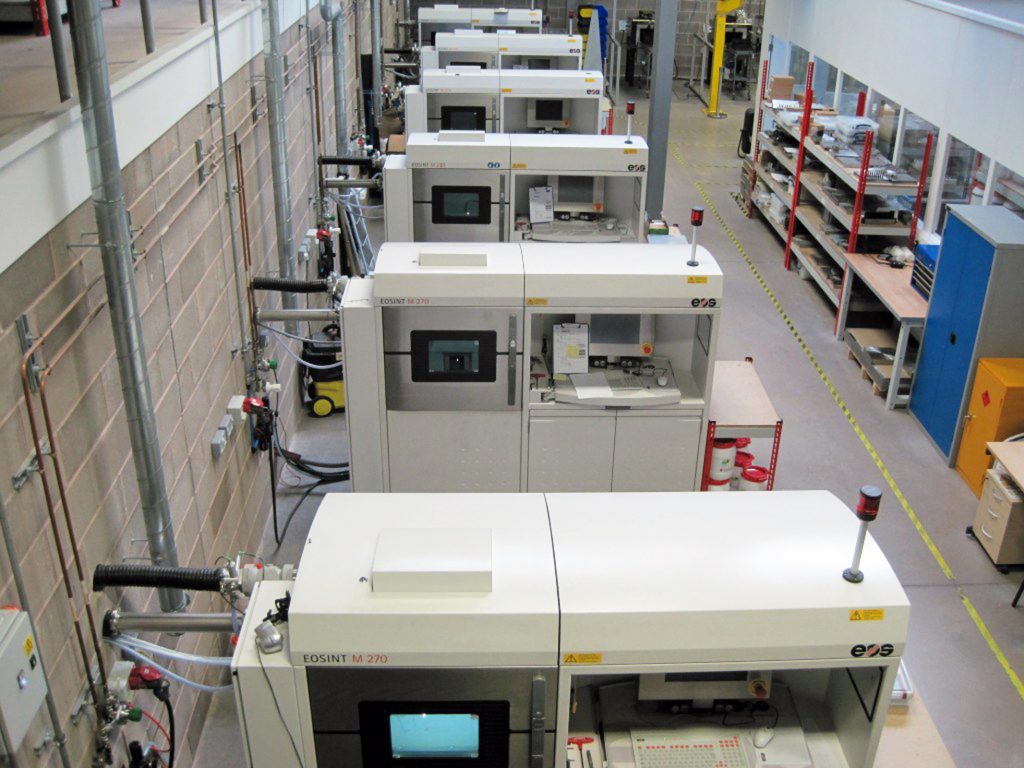
Shifting Additive Manufacturing from prototypes to performance components
From the outset, Materials Solutions recognised the opportunity to push Additive Manufacturing from its original focus on the building of models or prototypes, where material performance is of little or no significance, into the building of high performance functional components where control over mechanical properties of materials is of paramount importance. In this context, the company has accrued significant knowledge and expertise in understanding the interactions between SLM processing conditions and achievable material microstructures and mechanical properties and performance.
Furthermore, Materials Solutions has chosen to target application sectors where the required control over material quality and performance is exacting. The company is focused in particular on developing the highly specialised capability of manufacturing high temperature parts in superalloys for gas turbines and similar high performance applications, in geometries that cannot readily be machined to shape.
Superalloys are nickel, iron-nickel or cobalt-base alloys that are generally used at temperatures above 540°C and deliver unique combinations of high temperature strength, ductility and creep resistance and corrosion resistance. Additive manufactured superalloys can achieve excellent mechanical properties because of the fine grained microstructure produced, although the microstructure is also orientated and this anisotropy needs to be controlled and understood. A further advantage of AM of superalloys relates to the demonstrated potential for processing ‘difficult to weld’ materials such as CM247LC.

It has been found that AM process conditions need to be tailored to optimise fully the response of each particular alloy type and it can be concluded that the greatest benefits will be achieved when new alloys are specifically designed to match the requirements of the AM process.
The targeting of this specific market has required the development of not only materials and geometry competencies, but also quality procedures that meet the requirements of flight parts. In particular, Materials Solutions can process the highest temperature capable alloys required for advanced and next-generation aero-engines.
In pursuing these business objectives, the company has always viewed one of its key tasks as being the assisting of its key customers in advancing AM component developments up both the Technology Readiness Level (TRL) and Manufacturing Readiness Level (MRL) scales. In relation to the MRL scale, this has required the company to involve itself closely in supply chain development and approval.
Brancher told Metal Additive Manufacturing magazine, “The vision of this process is bold and the advantages claimed are substantial, but, in many cases, the technology is not developed to its full potential. Often, the supply chain is not in place, the requirements of clients are not fully understood and the advantages are more aspirational than proven. However, at Materials Solutions, we are developing the applications know-how and a supply chain for the world’s most advanced engineering companies.”
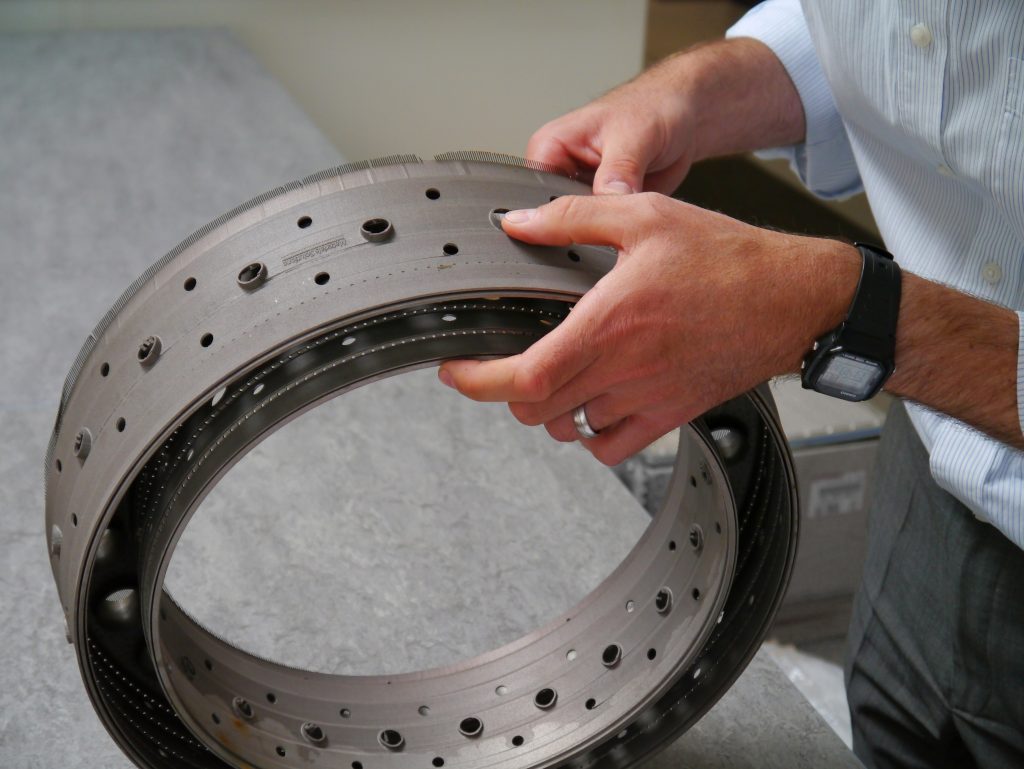
“We operate a flat organisation so all of our engineers develop a deep understanding of the technology by operating it on a daily basis. They discuss the requirements directly with our customers’ engineers and provide design-for-manufacture advice based on their practical knowledge learnt from years of experience.”
Brancher continued, “We specialise in high temperature alloys because it needs doing. Improved combustion processes reduce emissions and improve fuel consumption. This requires better fuel/air mixing, higher temperatures and better use of cooling air. So, novel designs in superalloys are our core skill.”
In relation to supply chain development, wherever possible, the company tries to select suppliers that already have approval from the relevant end-user for sub-contracted services, for example component final polishing to enhance surface finish.
High capacity Additive Manufacturing production facilities
In relation to equipment for primary AM component building, Materials Solutions currently has eight EOS machines, seven EOS M270 machines and one EOS M280 machine. Three further machines are due to arrive during 2015 – an M290, and two M400s. The M400 machines are capable of 400 x 400 mm builds and the company has already been involved (during 2014) as a beta test site for a prototype M400.
All AM processing is carried out under liquid source argon cover and all EOS machines are under full service contracts with EOS. The changes in SLM machine capabilities over the years are perceived by Brancher as being:
- Higher power lasers aimed at processing in thicker layers for faster processing and the processing of aluminium, which, being a high thermal conductivity/reflective material, needs more power
- Production specific machines that are thereby necessarily less flexible with respect to swapping between materials
- The introduction of machines with larger build volumes
- The introduction of a greater number of smaller SLM machines, some of these being specifically aimed at the laboratory market and for dental and jewellery applications.
Materials Solutions’ current suite of machines is one of the largest commercially available metals AM facilities in the world and is probably the largest one focussed on gas turbine component production.
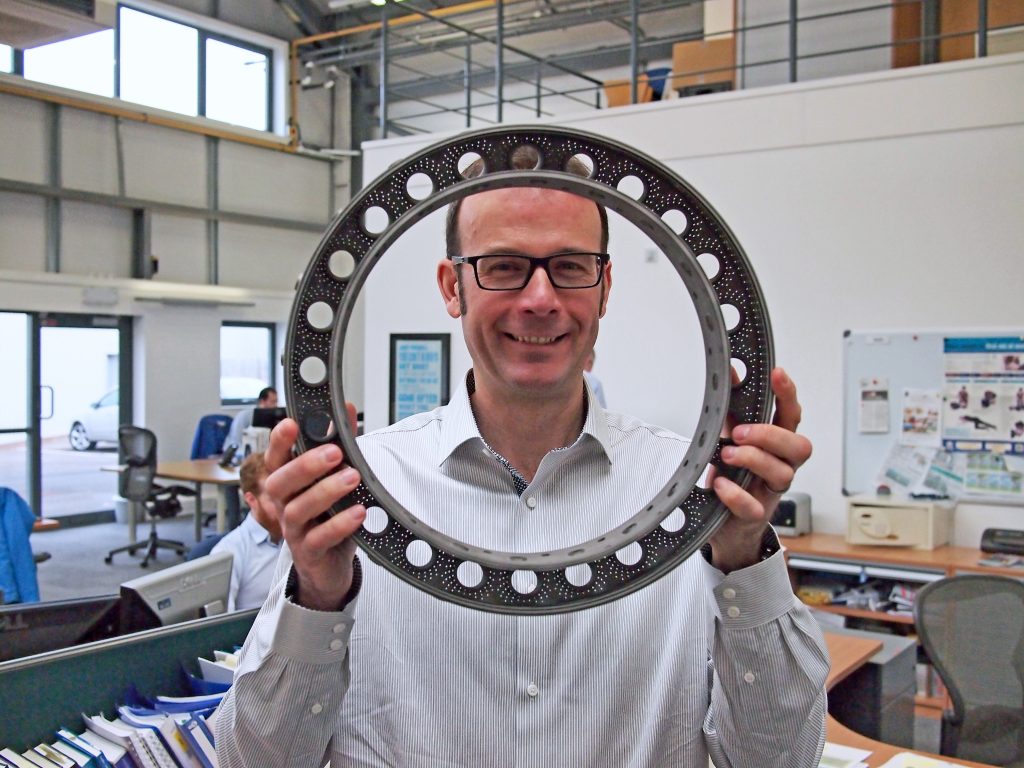
As well as the core Additive Manufacturing capability, Materials Solutions also has finishing process facilities in the form of abrasive blasting and wire EDM capability, its own heat treatment furnaces including a vacuum furnace, a machine shop and bench finishing.
For quality control, there is Rolls-Royce approved visual inspection, a metallographic laboratory equipped with optical and electron microscopes, a chemical analysis laboratory and calibrated pressure and flow benches for testing water and air flow and pressure.
Inspection capability includes a scanning programmable coordinate measuring machine and a GOM structured light 3D scanner, as well as traditional surface profilometry, shadowgraph and other tools.
Markets and materials
As mentioned previously, Materials Solutions’ main market focus is on components used in aero-engines and land-based gas turbines for power generation. In addition, the company has targeted applications in a number of other high-performance application sectors, such as aerospace fluidic components, motorsports and components for non-conventional power generation. Around 50% of sales revenues are derived from exports, with customers in Japan, North America and throughout Europe.
Material Solutions’ core competences are SLM materials capability and quality control. Materials processed by the company include Inconel 625 and Inconel 718, as well as other nickel based alloys such as Hastelloy X, C263, C1023 and CM247LC. Stainless steels such as 17-4 and 15-5 are also processed, along with maraging tool steel M300 and CoCrMo (Stellite). Recently, the company has added titanium capability and is building parts for aircraft and motorsports applications in Ti-6Al-4V. The CM247LC capability, in particular, is believed to be unique.
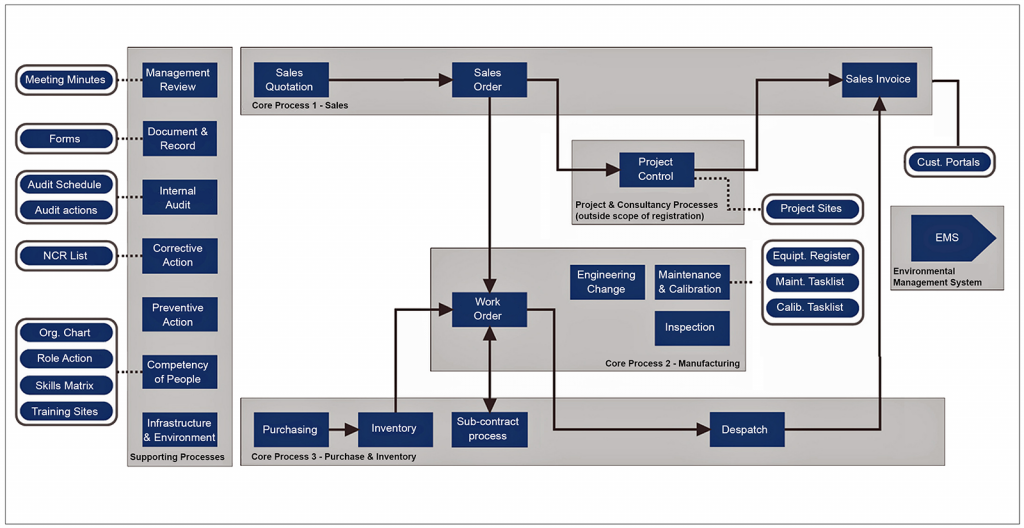
IT, production and quality management systems
To aid the company in delivering advanced products into its chosen target markets, Materials Solutions has developed an extremely sophisticated production and quality control system. This system is paperless and uses data entry points throughout the factory with bar code scanners for tracking operations and the movement of work in progress.
The IT operations are cloud hosted and accessed over the Internet via Citrix, except for customer files that are secured in-house. This IT structure provides security and scalability and, with 2-factor authentication, enables secure off-site access. The focus on process control and validation has led the company to develop and patent procedures and equipment to validate laser scan speed and powder re-coater speed, which, though both being key process variables, are not checked conventionally.
Accreditations and customer approvals
The company’s documented quality management system procedures and audited practices conform to key quality standards. Approval to ISO 9001:2008 has been in place since Jan 2008. Registration to the aerospace sector specific AS9100 Rev. C has been in place since May 2010 and was subsequently reissued to Rev. C Oct 2011. The company’s suppliers are also expected to comply with the same standards.
In addition, Materials Solutions has customer approvals for metal powder-bed Additive Manufacturing from; Rolls-Royce plc, Rolls-Royce Deutschland, Rolls-Royce Canada (now part of Siemens), Rolls-Royce Nuclear Sector, Industria de Turbo Propulsores (ITP Group), Sumitomo Precision Products and several other motorsport and aerospace companies that prefer Materials Solutions not to publicise.
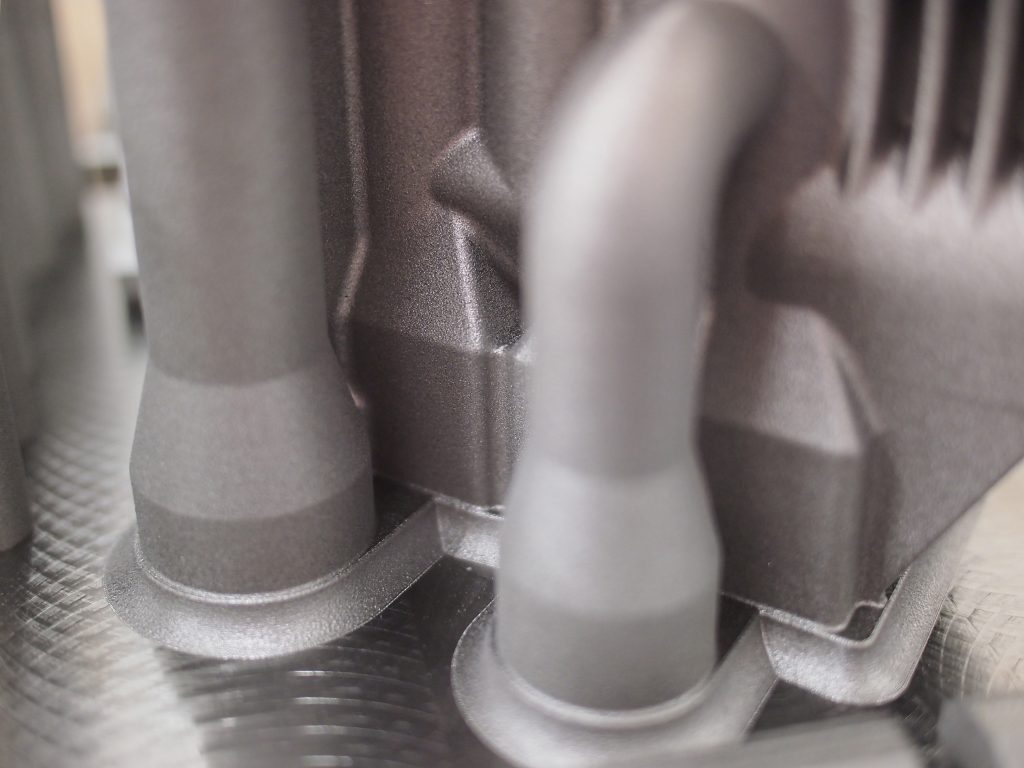
Intellectual property ownership
The issue of patent cover for procedures and equipment, developed by the company to validate the key process variables of laser scan speed and powder re-coater speed, has already been referred to. Materials Solutions now has a total of twelve issued patents, with a further eleven applications pending.
As a more general comment on the company’s approach to developing and protecting intellectual property, Brancher stated, “Additive Manufacturing is a new and IP-rich environment, which presents challenges to end-users for adoption as a manufacturing technology. There is always the concern that unintentional infringement may lead to additional costs or delays. To counter this risk, Materials Solutions files many patent applications both to test the scope of existing patents and also to generate new patents. These patents not only protect Materials Solutions IP, but also generate IP assets that may be used in bargaining situations. However, one area where Materials Solutions does not file patents is for any element of the design of parts made or enabled by Additive Manufacturing. This space we leave to our customers, as their IP “win”. We remain professionally blind to the designs we see and their function – what they are and what they do is of no interest to us. We make parts for many companies and, to us, they are simply geometries that need to be built to our customers’ designs and specifications.”
Thoughts on the future of metal Additive Manufacturing
In terms of the immediate outlook, Brancher sees 2015 as a growth year, not just for Materials Solutions, but also for the industry more generally. “There is an inflection point arriving soon and some big decisions are going to be made that will determine whether metals AM becomes main-stream, like EDM for instance, or remains a specialty process. In my opinion, the most exciting and fastest moving area will be in personal/polymer and my sense is that software tools and equipment development there (because it is so dynamic) will grow in sophistication and may provide some necessary elements to enable the revolution in metals manufacturing that has been outlined by the more evangelical wing of the metal AM community.”
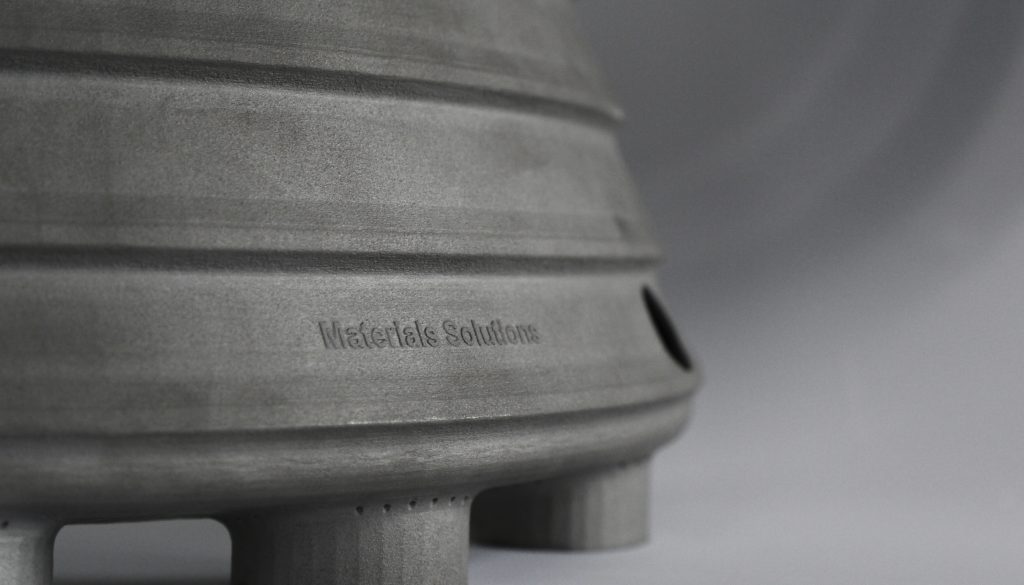
Design for Additive Manufacturing
In relation to the potential emergence of AM-friendly design concepts as an aid to adoption of the technology, Brancher commented that, “The AM process can build almost any design if enough support structures are added to it. So the question of additive-friendly design is really a question of cost and appropriateness of the manufacturing method. Under certain circumstances, a design is more appropriate for AM simply because making it any other way would take too long or cost too much. I do think that what AM has enabled is for designers to consider in depth the method of manufacture in ways that perhaps they have not done for conventional processes. By considering the manufacturing method, they are able to take advantage of it. Frequently we are shown designs that are difficult to make by any method as initially designed and toleranced. So there is a big ‘win’ associated with AM that is not specific to AM but is more one of considering the requirements of a design and what is functionally needed.”
Barriers to growth
In relation to potential barriers to the growth of metal AM in the next five or so years, Brancher stated that, “Customers often do not know what they require of a design e.g. what mechanical properties, surface finish etc. are required, as opposed to those that have been specified historically. This is critical because AM does not naturally reproduce the same surface finishes as machining processes, nor does it achieve the same properties as cast of forged materials. A lot of additional expense is needed to build parts additively and then post-process them to resemble products from a historical method.”
Brancher added that challenges for the metal powder supply chain to the AM sector relate to the achievement of consistency in chemical composition control and the reduction in achievable oxygen and nitrogen levels.
Additive Manufacturing in the technology life cycle
Concluding, Brancher told Metal Additive Manufacturing, “I had 25 years in the semiconductor industry and lived in Silicon Valley and then in Japan in the 1980s. AM currently is analogous to the early 1980s in the silicon processing time-line; simple machines and software tools and the technology walking around on legs. Considerable skills are needed to use the current generation of AM tools – it is like having a piano in the room, no more than an ornament unless you have learnt to play.”
“For AM to turn into something resembling a revolution, more of the technology must become embedded into the machines and software tools, allowing designers to design for function and have almost instant design verification and manufacturing routes mapped. This may never happen because of the wide diversity of designs, making the software development too complex and the costs too high. However, I do expect more Artificial Intelligence to be embedded in almost all aspects of professional life from medicine through to manufacture.”
Author
Dr David Whittaker
Tel: +44 1902 338498
Email: [email protected]
Contact
Carl Brancher
Materials Solutions
Unit 8 Great Western Business Park
McKenzie Way, Worcester, WR4 9GN
United Kingdom
Tel: +44 (0)1905 732160
Email: [email protected]
www.materialssolutions.co.uk







